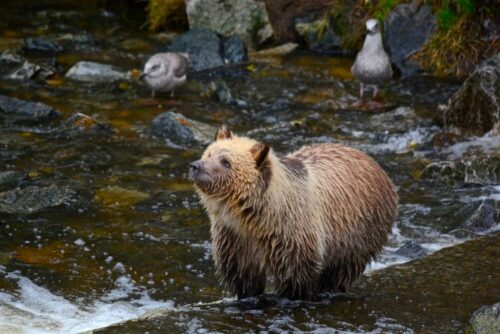Bears are one of the many species that are found all over the world, but bears in different parts of the world have a wide range of differences. From color to behavior, bears have adapted to their surroundings and evolved to look very different from one another. Two of the most well-known types of bears are the grizzly bear and the polar bear.
When you think of a grizzly bear, you probably conjure up the image of Smoky Bear in a big hat, warning campers about the dangers of forest fires, and because of this you likely learned at a young age that grizzly bears are forest dwellers. When you think of polar bears, it is likely that you also think of giant icebergs and white landscapes. Although these bears are the same species, they couldn’t be more different. Read below to find out just how different they are.

Color
One of the most obvious differences between grizzly and polar bears is their color. Grizzly bears are brown in color with fur that ranges in shades from light to dark. This coloring helps them blend into their surroundings so that they can easily move through the forest to hunt for prey. This is also beneficial for them if they don’t want to be spotted by nosey humans. The grizzly bear is one of many varieties of brown bears that can be seen in Asia, North America, and Europe, but when people refer to the grizzly bear, they are referring specifically to the brown bears that inhabit North America.
Polar bears are most well-known for their white fur, but the fur itself is not actually white at all. Polar bear fur is incredibly unique in that it is actually transparent and almost always looks white because of the reflections from the ice and snow in which it lives.
In contrast, polar bears have black skin underneath that thick coat in order to absorb and retain heat from the sun. You can see this in their muzzles and around their eyes, where less fur grows.
Size
In most people’s minds, when they think of a giant bear, the grizzly is the first to come to mind. This is because they are often portrayed in pop culture as huge compared to humans.
This is true as full-grown grizzly bears can grow up to nine feet tall when they are standing on their hind legs. Now, if you think that is big, one of the bear facts that most people don’t know is that polar bears are even bigger. This is a little-known fact because they are often photographed in polar climates where there is nothing but icebergs to compare their size to. In these types of photos, they look tiny compared to the massive landscapes surrounding them. Polar bears, in fact, can grow up to around ten feet tall, and the largest one ever recorded stood at twelve feet tall on his hind legs.
Diet
Due to the harsh climate in which polar bears live, they do not have many on-land options for cuisine. Because of this, they feed mostly on marine animals.
This can range from small fish to seals depending on what they can catch.
Because grizzly bears live in areas that are much more densely populated with wildlife, their diets are drastically different from polar bears. They have been known to dine on all kinds of plants and animals in order to stave off hunger. From small insects to large mammals like bison and elk, grizzly bears are not picky about their meals.
Native Habitats
Although it has been theorized by scientists that polar bears descend from brown bears and are likely closely related, the ancestors of the polar bear migrated to colder climates, causing them to evolve in different ways. Due to this adaptation, polar bears can withstand freezing temperatures and don’t really hibernate like other types of bears.
On the other hand, grizzly bears tend to stick to densely forested areas near rivers and lakes. The most popular places in North America to see grizzly bears are Alaska, Canada, and a lot of U.S. national parks including Yellowstone, Grand Teton, and Glacier National Park. Because grizzly bears live in areas where humans have begun to inhabit in the last few thousand years, they are more acclimatized to human behavior than polar bears.

These two types of bears, although they share a lot of the same genes, have adapted to their respective worlds in very different ways.
If you learned something new about grizzly or polar bears from this article, then you are on your way to being an advocate for their survival in this ever-changing world.





